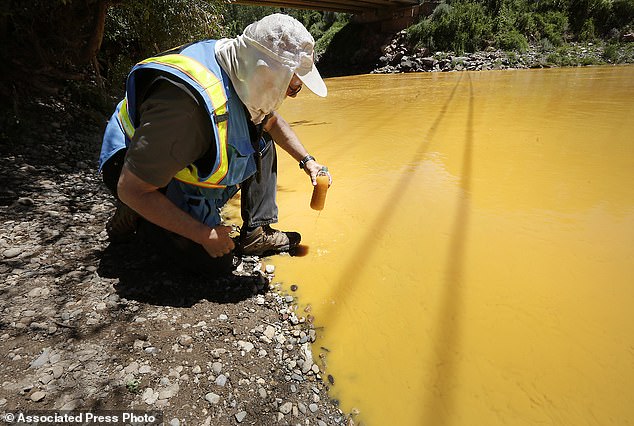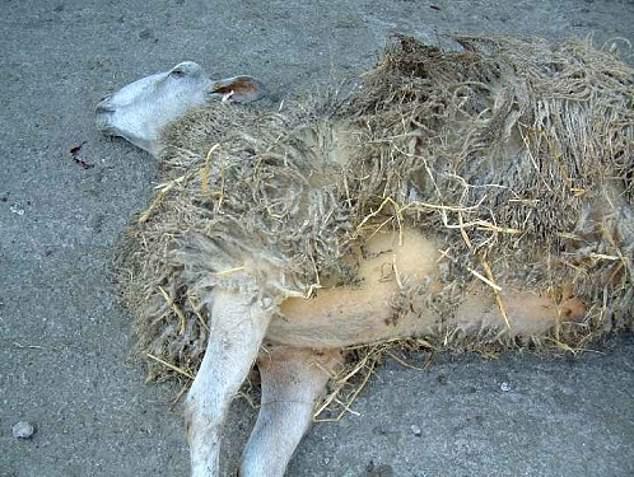Devastating risks of transitioning to ‘green’ energy: Mining for electric-powering minerals has left 23 million people exposed to toxic waste, 500,000km of rivers polluted and 16 million acres of farmland ruined
>
Tens of millions of people – more than live in the entire state of Florida – are now exposed to toxic water released from metal mining, a new study shows.
The report exposes the devastating consequences that could follow a reckless transition to ‘green’ energy, exacerbating the ecological damage caused by more than 150 years of drilling and mining for fossil fuels.
The researchers found that 23 million people worldwide, as well as 5.72 million livestock, more than 16 million acres of irrigated farmland and more than 477,800 miles of rivers are polluted by the toxic byproducts of mining seeping into the water.
This metal mining includes many so-called ‘rare earth elements’ that are essential for the production of high-tech electronics, solar cells, wind turbines and all the batteries needed to store sustainable ‘green’ energy (and power electric cars and iPhones).
Although the new study focuses on environmental impacts, the global metals mining industry has recently faced shocking lawsuits against major tech companies, including Apple, Google, Microsoft and Tesla, over child slavery in Congo, where 70 percent of the cobalt in the industry comes from.
Researchers found that more than 477,800 kilometers of rivers have been polluted by toxic byproducts of mining. Above, an aerial photo from March 27, 2021 of an area contaminated with toxic waste generated by mining companies that have polluted Bolivia’s Tagarete River

The scientists found that 23 million people worldwide have been exposed to toxic mine waste. Above, Dan Bender of the La Plata County Sheriff’s Office takes a sample from Colorado’s Animas River, contaminated by approximately 3 million gallons of waste from the Gold King Mine
“Rapid growth in global metal mining is crucial if the world is to transition to green energy,” he says Chris Thomasa zoologist at the University of Lincoln, whose specialty is spatial ecology and threats to global water supplies.
Thomas led the analysis and modeling work for the new study, which was published today Science.
Thomas and his colleagues have developed a new database, supported by on-site testing, that now maps the hundreds of square kilometers of rivers and floodplains polluted by these industrial processes around the world.
The devastation caused by this pollution, they found, was widespread, affecting a total of about 479,200 km of river systems and more than 164,000 square kilometers of floodplains worldwide.
But North America stood out as the hardest-hit country, with 200,000 kilometers of polluted river systems and about 10.7 million hectares of polluted floodplains.
But the damage was not much better in South America, where 80,766 kilometers of rivers and more than 9.5 million hectares of floodplains were affected; nor in Asia, where approximately 37,842 river miles and approximately 3.3 million hectares of floodplains are contaminated by metal mining waste.
In terms of the potential for local damage, however, the scientists have reserved their strongest criticism for ‘the ecological legacy of historic mining’, which they say is ‘most problematic in Western Europe’, where long-abandoned old mines are causing lasting damage to the have caused to the environment. .
“Much of the estimated global contamination we mapped is a legacy of the industrial age,” Thomas said in a press statement. “Modern mining is rightly encouraged to prioritize environmental sustainability.”
The researchers developed a model to predict the spread of contaminants from all known active and inactive metal mines – plus facilities used to seal hazardous mining waste – with an emphasis on pollution from lead, zinc, copper and arsenic.

Potentially harmful mining contaminants can enter local water supplies, whether transported downstream to riverbeds and floodplains, or deep in underground aquifers. Chronic copper metal poisoning kills a sheep in North Ronaldsay, Texel, Suffolk
These potentially harmful contaminants and industrial byproducts can enter the local water supply, whether they are transported downstream where the metals are deposited along riverbeds and floodplains, or otherwise sink deep into underground aquifers.
Mark Macklin, director of the university’s Lincoln Center for Water and Planetary Health, who led the international team behind the new research, said he expects the new study’s maps and modeling tools will help prevent future reckless mining.
“We expect this will make it easier to mitigate the environmental impacts of historic and current mining,” Macklin said.
‘Our new method for predicting the distribution of mining waste in river systems provides governments, environmental regulators, the mining industry and local communities with a tool to assess, for the first time, the external and downstream impacts of mining on the ecosystem. and human health.’
